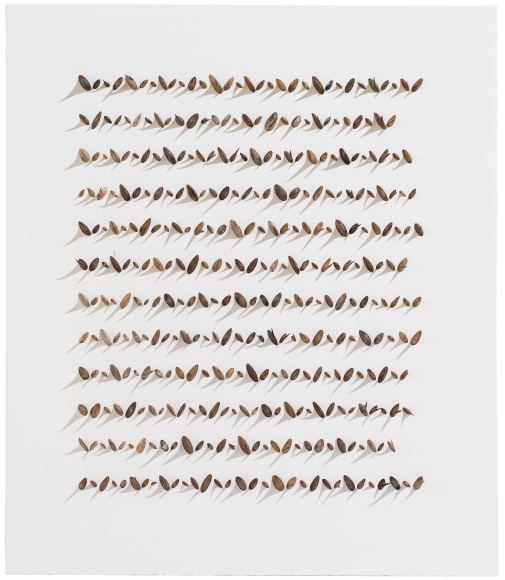Chambers Fine Art is pleased to announce the opening on September 17 of Cui Fei: Tracing the Origin II. Cui Fei was born in 1970 in Jinan, Shandong Province. After graduating from the China Academy of Fine Arts, Hangzhou, she moved to the United States in 1996 and has been resident there ever since. Although painting was the primary focus in the rst decade of her career, Cui Fei began to create works using materials from the natural world in the mid-1990s and this was soon to become the distinguishing feature of her artistic practice. She has described how the experience of being a Chinese artist in the United States and witnessing radical changes in China led to a heightened awareness of the relationship between man and nature that has been lost. “I see nature,” she has said, “as consistent and ordered, thus providing a therapeutic agent for healing and harmony in an otherwise chaotic world. I utilize materials found in nature such as tendrils, leaves and thorns composing a manuscript symbolizing the voiceless messages in nature that are waiting to be discovered and to be heard.”
Her work may thus be seen as an ongoing process of gathering materials from the natural world which she seeks out in di erent locations and seasons depending on the nature of the plants and of ordering and presenting them in a coherent manner in the privacy of her studio or in the public space of a gallery or museum. Each of the ongoing series of works that have preoccupied her for the last 15 years –Tracing the Origin series, Manuscript of Nature series, Read by Touch, Diary and others – has a di erent focus although the basic procedure remains the same. In the current exhibition works from Read by Touch and Manuscript of Nature are notably di erent in impact. In the former thorns from black locust or honey locust trees and rose bushes are presented in horizontal lines representing units of time, the invitation to read by touch emphasizing the possibility of a painful encounter with the wickedly sharp thorns. There is a tension between the irregular forms of the thorns, each one unique, and the rigid way in which they are arranged.
In the latter, dried grape tendrils are aligned vertically, resembling Chinese calligraphy strokes written in grass style. Cui Fei has made many variations on this theme, presenting the material as framed works but also as installations in Manuscript of Nature V. In the latter the tendrils are pinned directly to the wall, the size of the work depending on the proportions of the space in which they are exhibited.
Another key work is Not Yet Titled in which individual units consisting of five thorns, four vertical and one horizontal tied together with twine, are attached directly to the wall of the exhibition space. As described in a recent analysis of Cui Fei’s work, “Each thorn represents one day, and the rows represent months. Each column is a year, or part of a year. Not Yet Titled counts out the duration of the second Sino-Japanese War, which lasted from 1937 to 1945. Every thorn represents another day of su ering. Looking at the tallies spread across the wall, one begins to take in how long that su ering lasted.”
In Cui Fei’s work there is always a tension between the found materials from the natural world that she uses as her medium and the methodical way in which this is presented whether in installations or independent works. Although she uses materials from the natural world rather than more traditional media, she explores themes that range from the personal and private to the universal.
前波画廊诚挚地宣布《崔斐:溯源II》将于9月17日开幕。崔斐1970年出生于山东济南,从浙江美术学院(现中国美术学院)毕业后,于1996年移居美国。
虽然崔斐早期的创作重点以油画为主,但到九十年代末期,她开始使用从自然界中收集到的材料作为创作媒材,并以此形成了其独特的创作风格。作为一名在美国工作和生活的中国艺术家,崔斐曾目睹中国所发生的翻天覆地的变化。在她看来,自然是永恒、和谐而有序的,它为这个纷繁嘈杂的世界提供了一种治愈的方法。通过用这些从自然界中搜集来的藤枝、树叶和树刺等材料来组成各类手稿,犹如大自然中等待人们去发掘和倾听的无言的心声。
崔斐持续地在不同的地方和季节,根据植物的习性来从自然界中采集物料,然后在她个人的工作室,画廊或美术馆等公共场所将这些物料井然有序地排列和展现出来。过去15年来的几个作品系列里,包括“溯源”、“自然的手稿”和以时间为主题的系列等,虽然是各自不同的主题和特点,但却保持着相同的创作方式和过程。
在本次展览中,以时间为主题的系列和“自然的手稿”这两个系列所展现出的视觉效果截然不同。在前一个系列中,皂荚树刺以及玫瑰花刺被横向排列成“时间单位”,似乎邀请人们用手触摸这些尖刺来唤起曾可能遭遇过的疼痛记忆。这些刺各不相同,却排列极为严谨,以至于在不规则的个体和规则的形态之间漫延着一种张力。
在“自然的手稿”系列中,干枯的葡萄藤枝被纵向排列犹如中国草书一般,崔斐根据这一主题创作了一系列不同的作品。此次展览作品“自然的手稿Ⅴ”,除了装裱在画框中之外,还有被直接钉在墙面上的装置,而作品的尺寸则根据展厅空间的大小比例来决定。
另一件主要作品“未命名”中每一个单位元素由五根树刺组成,包括四根纵向和一根横向并用线缠在一起,这些元素被直接排列在展厅墙上。如最近对崔斐作品的研究所述,“每一根刺代表一天,每一行代表一个月,每一列代表一年。‘未命名’记录了中国抗日战争的持续时间,即1937年至1945年。每一根刺代表了一天所遭受的苦难。看着这堵排满树刺的墙,观者可以体会到那是多长时间的苦难。”
在崔斐的作品中,自然界中所收集到的材料与有条不紊的排列和创作方式之间,总是存在着一种张力。虽然她采用的是非传统媒材的创作方式,但却探讨了从个人到普遍性的主题。


